BLC303/05 Supply Chain Management TMA 2 Report: Competitive Factors
VerifiedAdded on 2023/06/03
|6
|1680
|159
Report
AI Summary
This report examines supply chain management principles and their application in the context of smartphone manufacturers and a local fast-food company, Marrybrown. The first part of the report identifies and justifies five key competitive factors—quality, cost, flexibility, delivery, and innovation—essential for an effective smartphone supply chain. It delves into how these factors can be optimized through strategies like lean six sigma, cost-efficient resource allocation, design flexibility, and technological integration. The second part of the report performs a SWOT analysis on Marrybrown's supply chain, evaluating its strengths (e.g., experience, local supplier relationships), weaknesses (e.g., limited geographical focus, complex processes), opportunities (e.g., technological integration, international expansion), and threats (e.g., competition from larger fast-food chains). The report highlights the importance of adapting to industry 4.0 technologies and building a robust supply chain to maintain competitiveness.
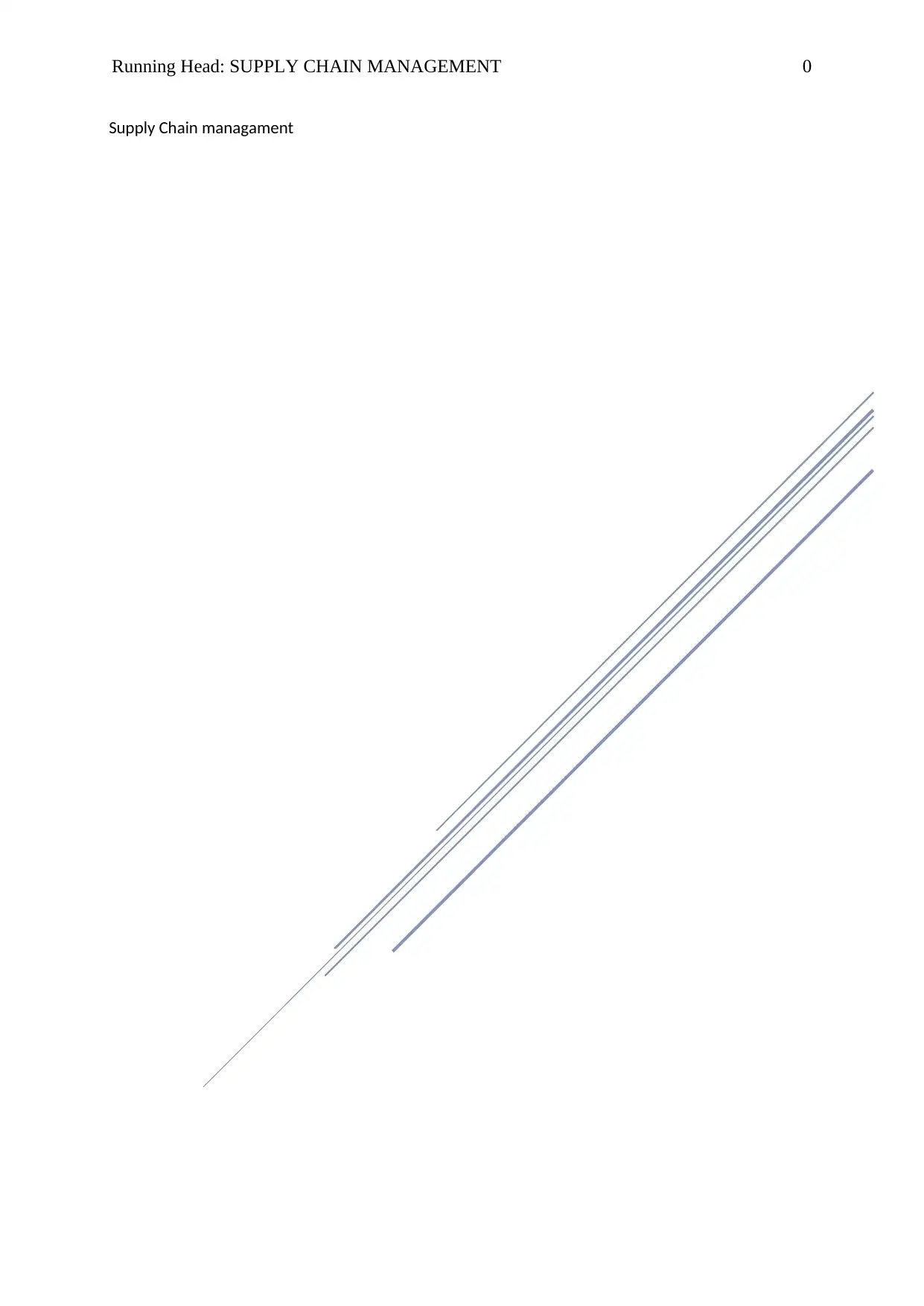
Running Head: SUPPLY CHAIN MANAGEMENT 0
Supply Chain managament
Supply Chain managament
Paraphrase This Document
Need a fresh take? Get an instant paraphrase of this document with our AI Paraphraser
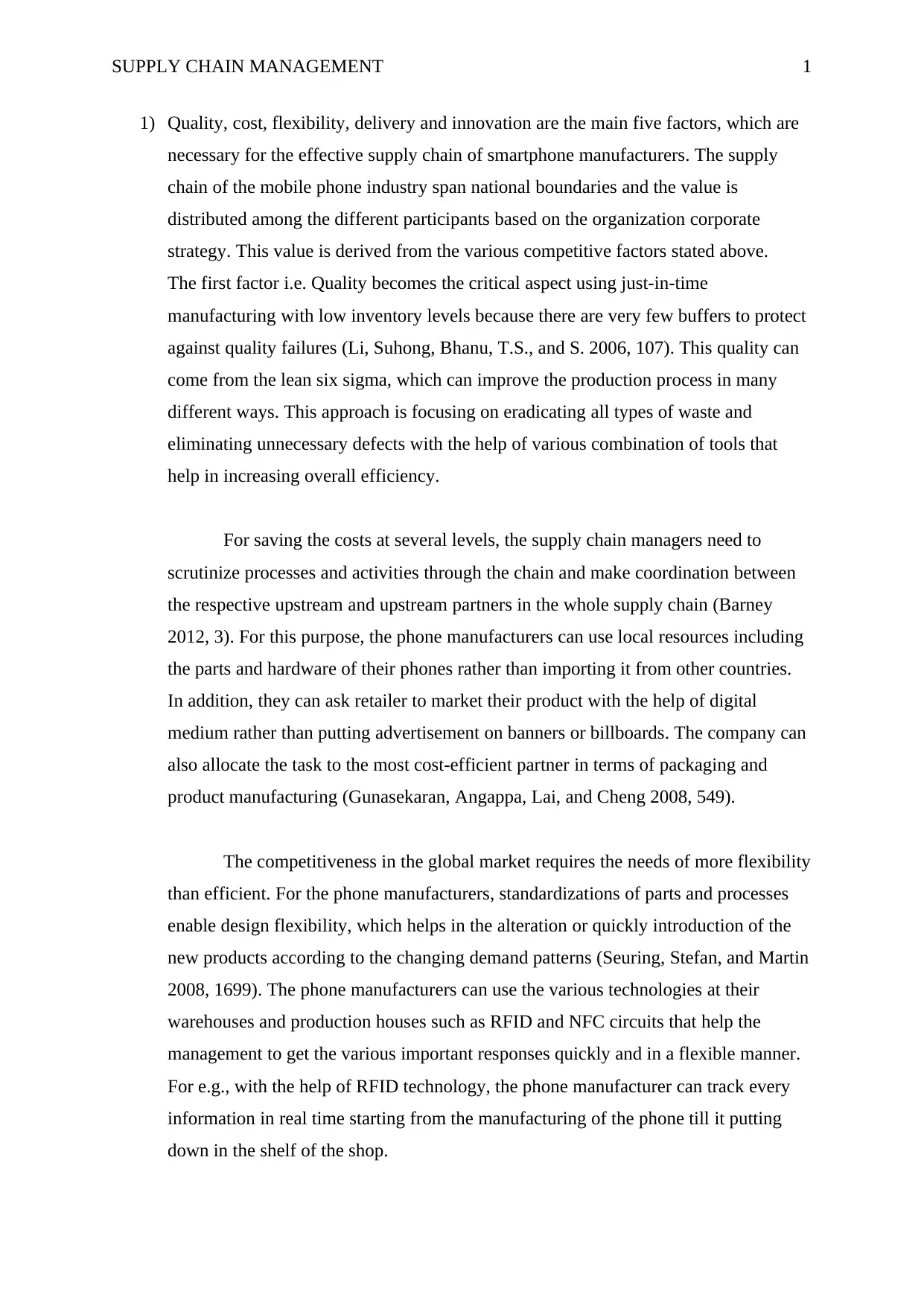
SUPPLY CHAIN MANAGEMENT 1
1) Quality, cost, flexibility, delivery and innovation are the main five factors, which are
necessary for the effective supply chain of smartphone manufacturers. The supply
chain of the mobile phone industry span national boundaries and the value is
distributed among the different participants based on the organization corporate
strategy. This value is derived from the various competitive factors stated above.
The first factor i.e. Quality becomes the critical aspect using just-in-time
manufacturing with low inventory levels because there are very few buffers to protect
against quality failures (Li, Suhong, Bhanu, T.S., and S. 2006, 107). This quality can
come from the lean six sigma, which can improve the production process in many
different ways. This approach is focusing on eradicating all types of waste and
eliminating unnecessary defects with the help of various combination of tools that
help in increasing overall efficiency.
For saving the costs at several levels, the supply chain managers need to
scrutinize processes and activities through the chain and make coordination between
the respective upstream and upstream partners in the whole supply chain (Barney
2012, 3). For this purpose, the phone manufacturers can use local resources including
the parts and hardware of their phones rather than importing it from other countries.
In addition, they can ask retailer to market their product with the help of digital
medium rather than putting advertisement on banners or billboards. The company can
also allocate the task to the most cost-efficient partner in terms of packaging and
product manufacturing (Gunasekaran, Angappa, Lai, and Cheng 2008, 549).
The competitiveness in the global market requires the needs of more flexibility
than efficient. For the phone manufacturers, standardizations of parts and processes
enable design flexibility, which helps in the alteration or quickly introduction of the
new products according to the changing demand patterns (Seuring, Stefan, and Martin
2008, 1699). The phone manufacturers can use the various technologies at their
warehouses and production houses such as RFID and NFC circuits that help the
management to get the various important responses quickly and in a flexible manner.
For e.g., with the help of RFID technology, the phone manufacturer can track every
information in real time starting from the manufacturing of the phone till it putting
down in the shelf of the shop.
1) Quality, cost, flexibility, delivery and innovation are the main five factors, which are
necessary for the effective supply chain of smartphone manufacturers. The supply
chain of the mobile phone industry span national boundaries and the value is
distributed among the different participants based on the organization corporate
strategy. This value is derived from the various competitive factors stated above.
The first factor i.e. Quality becomes the critical aspect using just-in-time
manufacturing with low inventory levels because there are very few buffers to protect
against quality failures (Li, Suhong, Bhanu, T.S., and S. 2006, 107). This quality can
come from the lean six sigma, which can improve the production process in many
different ways. This approach is focusing on eradicating all types of waste and
eliminating unnecessary defects with the help of various combination of tools that
help in increasing overall efficiency.
For saving the costs at several levels, the supply chain managers need to
scrutinize processes and activities through the chain and make coordination between
the respective upstream and upstream partners in the whole supply chain (Barney
2012, 3). For this purpose, the phone manufacturers can use local resources including
the parts and hardware of their phones rather than importing it from other countries.
In addition, they can ask retailer to market their product with the help of digital
medium rather than putting advertisement on banners or billboards. The company can
also allocate the task to the most cost-efficient partner in terms of packaging and
product manufacturing (Gunasekaran, Angappa, Lai, and Cheng 2008, 549).
The competitiveness in the global market requires the needs of more flexibility
than efficient. For the phone manufacturers, standardizations of parts and processes
enable design flexibility, which helps in the alteration or quickly introduction of the
new products according to the changing demand patterns (Seuring, Stefan, and Martin
2008, 1699). The phone manufacturers can use the various technologies at their
warehouses and production houses such as RFID and NFC circuits that help the
management to get the various important responses quickly and in a flexible manner.
For e.g., with the help of RFID technology, the phone manufacturer can track every
information in real time starting from the manufacturing of the phone till it putting
down in the shelf of the shop.
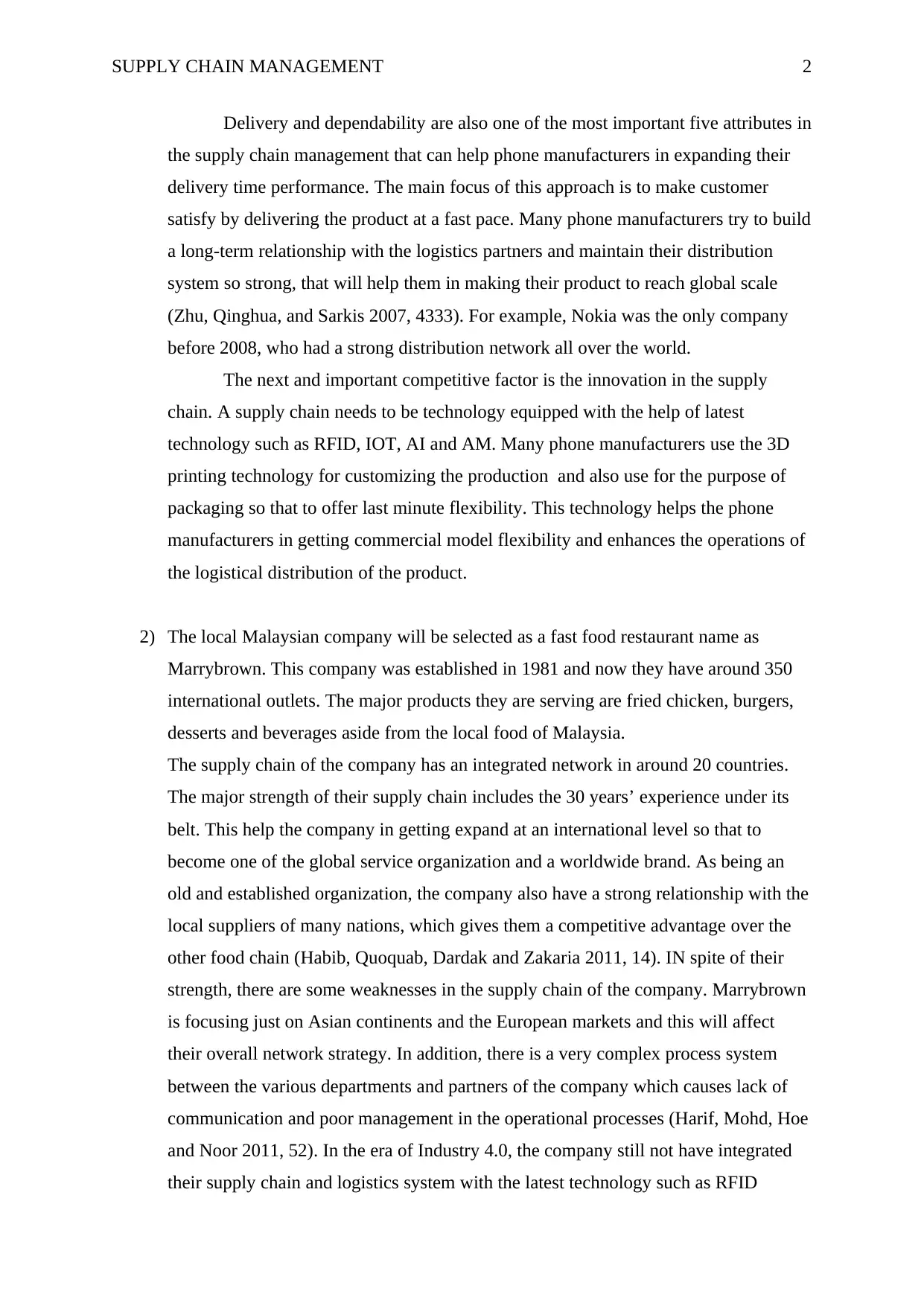
SUPPLY CHAIN MANAGEMENT 2
Delivery and dependability are also one of the most important five attributes in
the supply chain management that can help phone manufacturers in expanding their
delivery time performance. The main focus of this approach is to make customer
satisfy by delivering the product at a fast pace. Many phone manufacturers try to build
a long-term relationship with the logistics partners and maintain their distribution
system so strong, that will help them in making their product to reach global scale
(Zhu, Qinghua, and Sarkis 2007, 4333). For example, Nokia was the only company
before 2008, who had a strong distribution network all over the world.
The next and important competitive factor is the innovation in the supply
chain. A supply chain needs to be technology equipped with the help of latest
technology such as RFID, IOT, AI and AM. Many phone manufacturers use the 3D
printing technology for customizing the production and also use for the purpose of
packaging so that to offer last minute flexibility. This technology helps the phone
manufacturers in getting commercial model flexibility and enhances the operations of
the logistical distribution of the product.
2) The local Malaysian company will be selected as a fast food restaurant name as
Marrybrown. This company was established in 1981 and now they have around 350
international outlets. The major products they are serving are fried chicken, burgers,
desserts and beverages aside from the local food of Malaysia.
The supply chain of the company has an integrated network in around 20 countries.
The major strength of their supply chain includes the 30 years’ experience under its
belt. This help the company in getting expand at an international level so that to
become one of the global service organization and a worldwide brand. As being an
old and established organization, the company also have a strong relationship with the
local suppliers of many nations, which gives them a competitive advantage over the
other food chain (Habib, Quoquab, Dardak and Zakaria 2011, 14). IN spite of their
strength, there are some weaknesses in the supply chain of the company. Marrybrown
is focusing just on Asian continents and the European markets and this will affect
their overall network strategy. In addition, there is a very complex process system
between the various departments and partners of the company which causes lack of
communication and poor management in the operational processes (Harif, Mohd, Hoe
and Noor 2011, 52). In the era of Industry 4.0, the company still not have integrated
their supply chain and logistics system with the latest technology such as RFID
Delivery and dependability are also one of the most important five attributes in
the supply chain management that can help phone manufacturers in expanding their
delivery time performance. The main focus of this approach is to make customer
satisfy by delivering the product at a fast pace. Many phone manufacturers try to build
a long-term relationship with the logistics partners and maintain their distribution
system so strong, that will help them in making their product to reach global scale
(Zhu, Qinghua, and Sarkis 2007, 4333). For example, Nokia was the only company
before 2008, who had a strong distribution network all over the world.
The next and important competitive factor is the innovation in the supply
chain. A supply chain needs to be technology equipped with the help of latest
technology such as RFID, IOT, AI and AM. Many phone manufacturers use the 3D
printing technology for customizing the production and also use for the purpose of
packaging so that to offer last minute flexibility. This technology helps the phone
manufacturers in getting commercial model flexibility and enhances the operations of
the logistical distribution of the product.
2) The local Malaysian company will be selected as a fast food restaurant name as
Marrybrown. This company was established in 1981 and now they have around 350
international outlets. The major products they are serving are fried chicken, burgers,
desserts and beverages aside from the local food of Malaysia.
The supply chain of the company has an integrated network in around 20 countries.
The major strength of their supply chain includes the 30 years’ experience under its
belt. This help the company in getting expand at an international level so that to
become one of the global service organization and a worldwide brand. As being an
old and established organization, the company also have a strong relationship with the
local suppliers of many nations, which gives them a competitive advantage over the
other food chain (Habib, Quoquab, Dardak and Zakaria 2011, 14). IN spite of their
strength, there are some weaknesses in the supply chain of the company. Marrybrown
is focusing just on Asian continents and the European markets and this will affect
their overall network strategy. In addition, there is a very complex process system
between the various departments and partners of the company which causes lack of
communication and poor management in the operational processes (Harif, Mohd, Hoe
and Noor 2011, 52). In the era of Industry 4.0, the company still not have integrated
their supply chain and logistics system with the latest technology such as RFID
⊘ This is a preview!⊘
Do you want full access?
Subscribe today to unlock all pages.

Trusted by 1+ million students worldwide
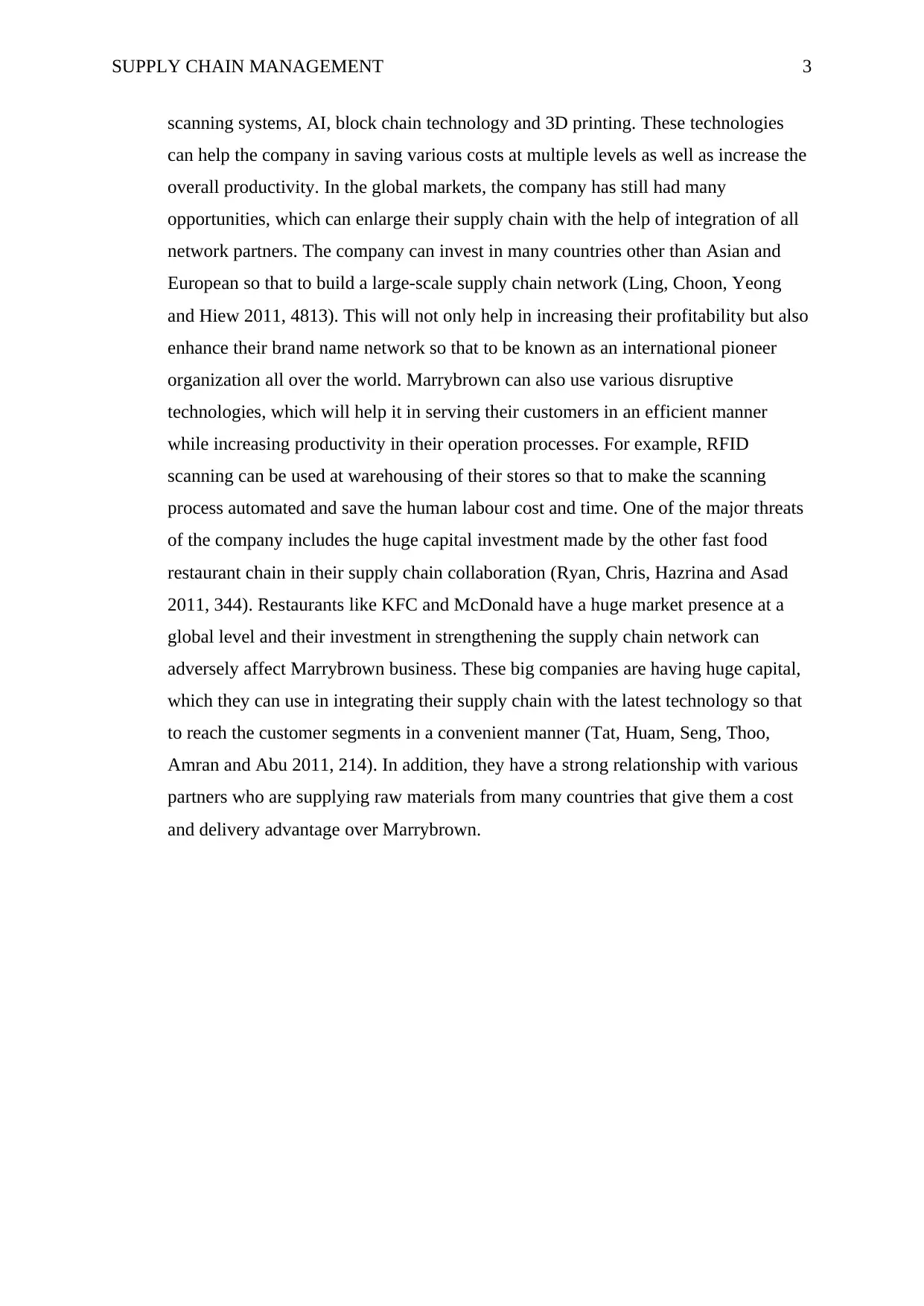
SUPPLY CHAIN MANAGEMENT 3
scanning systems, AI, block chain technology and 3D printing. These technologies
can help the company in saving various costs at multiple levels as well as increase the
overall productivity. In the global markets, the company has still had many
opportunities, which can enlarge their supply chain with the help of integration of all
network partners. The company can invest in many countries other than Asian and
European so that to build a large-scale supply chain network (Ling, Choon, Yeong
and Hiew 2011, 4813). This will not only help in increasing their profitability but also
enhance their brand name network so that to be known as an international pioneer
organization all over the world. Marrybrown can also use various disruptive
technologies, which will help it in serving their customers in an efficient manner
while increasing productivity in their operation processes. For example, RFID
scanning can be used at warehousing of their stores so that to make the scanning
process automated and save the human labour cost and time. One of the major threats
of the company includes the huge capital investment made by the other fast food
restaurant chain in their supply chain collaboration (Ryan, Chris, Hazrina and Asad
2011, 344). Restaurants like KFC and McDonald have a huge market presence at a
global level and their investment in strengthening the supply chain network can
adversely affect Marrybrown business. These big companies are having huge capital,
which they can use in integrating their supply chain with the latest technology so that
to reach the customer segments in a convenient manner (Tat, Huam, Seng, Thoo,
Amran and Abu 2011, 214). In addition, they have a strong relationship with various
partners who are supplying raw materials from many countries that give them a cost
and delivery advantage over Marrybrown.
scanning systems, AI, block chain technology and 3D printing. These technologies
can help the company in saving various costs at multiple levels as well as increase the
overall productivity. In the global markets, the company has still had many
opportunities, which can enlarge their supply chain with the help of integration of all
network partners. The company can invest in many countries other than Asian and
European so that to build a large-scale supply chain network (Ling, Choon, Yeong
and Hiew 2011, 4813). This will not only help in increasing their profitability but also
enhance their brand name network so that to be known as an international pioneer
organization all over the world. Marrybrown can also use various disruptive
technologies, which will help it in serving their customers in an efficient manner
while increasing productivity in their operation processes. For example, RFID
scanning can be used at warehousing of their stores so that to make the scanning
process automated and save the human labour cost and time. One of the major threats
of the company includes the huge capital investment made by the other fast food
restaurant chain in their supply chain collaboration (Ryan, Chris, Hazrina and Asad
2011, 344). Restaurants like KFC and McDonald have a huge market presence at a
global level and their investment in strengthening the supply chain network can
adversely affect Marrybrown business. These big companies are having huge capital,
which they can use in integrating their supply chain with the latest technology so that
to reach the customer segments in a convenient manner (Tat, Huam, Seng, Thoo,
Amran and Abu 2011, 214). In addition, they have a strong relationship with various
partners who are supplying raw materials from many countries that give them a cost
and delivery advantage over Marrybrown.
Paraphrase This Document
Need a fresh take? Get an instant paraphrase of this document with our AI Paraphraser
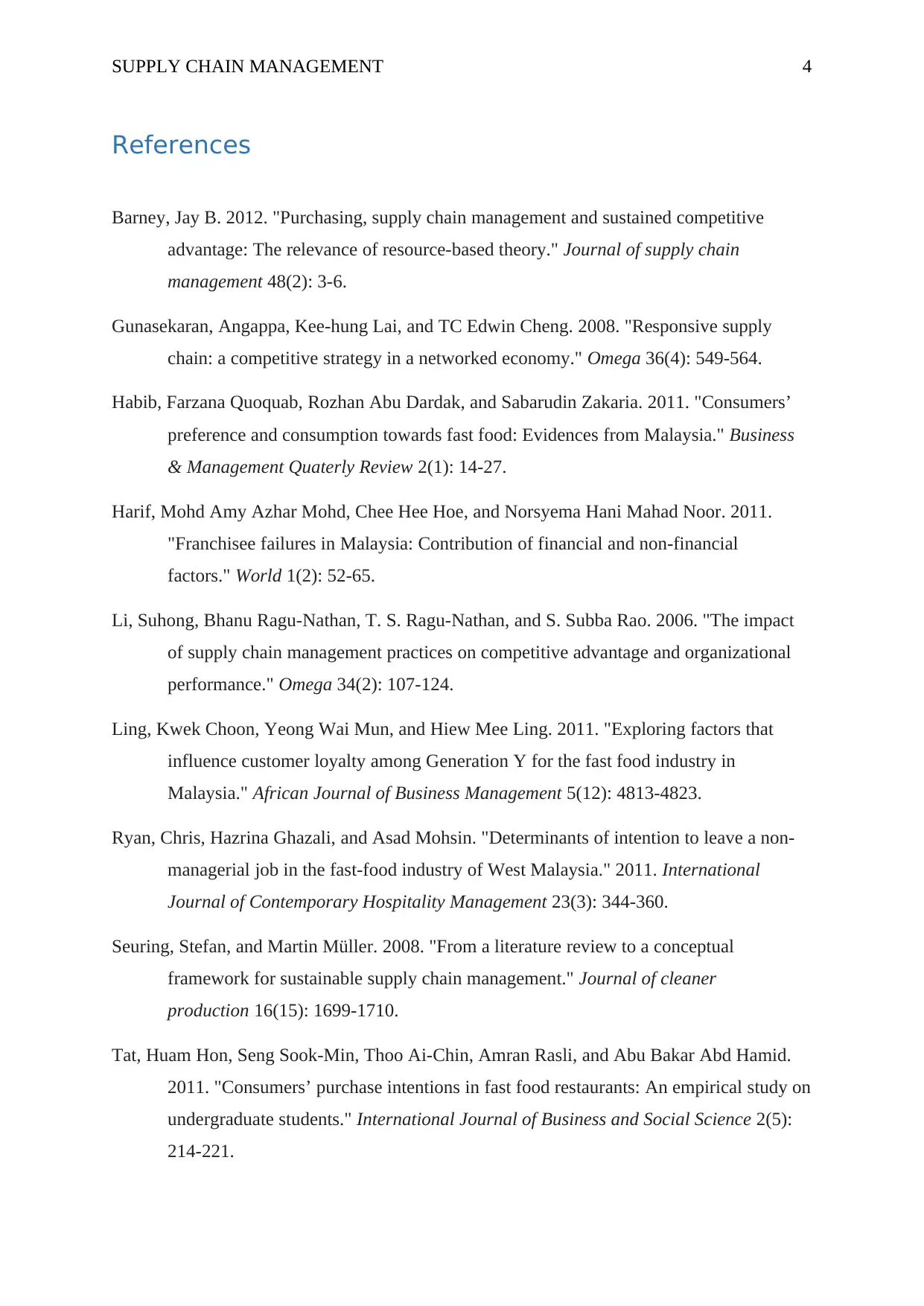
SUPPLY CHAIN MANAGEMENT 4
References
Barney, Jay B. 2012. "Purchasing, supply chain management and sustained competitive
advantage: The relevance of resource‐based theory." Journal of supply chain
management 48(2): 3-6.
Gunasekaran, Angappa, Kee-hung Lai, and TC Edwin Cheng. 2008. "Responsive supply
chain: a competitive strategy in a networked economy." Omega 36(4): 549-564.
Habib, Farzana Quoquab, Rozhan Abu Dardak, and Sabarudin Zakaria. 2011. "Consumers’
preference and consumption towards fast food: Evidences from Malaysia." Business
& Management Quaterly Review 2(1): 14-27.
Harif, Mohd Amy Azhar Mohd, Chee Hee Hoe, and Norsyema Hani Mahad Noor. 2011.
"Franchisee failures in Malaysia: Contribution of financial and non-financial
factors." World 1(2): 52-65.
Li, Suhong, Bhanu Ragu-Nathan, T. S. Ragu-Nathan, and S. Subba Rao. 2006. "The impact
of supply chain management practices on competitive advantage and organizational
performance." Omega 34(2): 107-124.
Ling, Kwek Choon, Yeong Wai Mun, and Hiew Mee Ling. 2011. "Exploring factors that
influence customer loyalty among Generation Y for the fast food industry in
Malaysia." African Journal of Business Management 5(12): 4813-4823.
Ryan, Chris, Hazrina Ghazali, and Asad Mohsin. "Determinants of intention to leave a non-
managerial job in the fast-food industry of West Malaysia." 2011. International
Journal of Contemporary Hospitality Management 23(3): 344-360.
Seuring, Stefan, and Martin Müller. 2008. "From a literature review to a conceptual
framework for sustainable supply chain management." Journal of cleaner
production 16(15): 1699-1710.
Tat, Huam Hon, Seng Sook-Min, Thoo Ai-Chin, Amran Rasli, and Abu Bakar Abd Hamid.
2011. "Consumers’ purchase intentions in fast food restaurants: An empirical study on
undergraduate students." International Journal of Business and Social Science 2(5):
214-221.
References
Barney, Jay B. 2012. "Purchasing, supply chain management and sustained competitive
advantage: The relevance of resource‐based theory." Journal of supply chain
management 48(2): 3-6.
Gunasekaran, Angappa, Kee-hung Lai, and TC Edwin Cheng. 2008. "Responsive supply
chain: a competitive strategy in a networked economy." Omega 36(4): 549-564.
Habib, Farzana Quoquab, Rozhan Abu Dardak, and Sabarudin Zakaria. 2011. "Consumers’
preference and consumption towards fast food: Evidences from Malaysia." Business
& Management Quaterly Review 2(1): 14-27.
Harif, Mohd Amy Azhar Mohd, Chee Hee Hoe, and Norsyema Hani Mahad Noor. 2011.
"Franchisee failures in Malaysia: Contribution of financial and non-financial
factors." World 1(2): 52-65.
Li, Suhong, Bhanu Ragu-Nathan, T. S. Ragu-Nathan, and S. Subba Rao. 2006. "The impact
of supply chain management practices on competitive advantage and organizational
performance." Omega 34(2): 107-124.
Ling, Kwek Choon, Yeong Wai Mun, and Hiew Mee Ling. 2011. "Exploring factors that
influence customer loyalty among Generation Y for the fast food industry in
Malaysia." African Journal of Business Management 5(12): 4813-4823.
Ryan, Chris, Hazrina Ghazali, and Asad Mohsin. "Determinants of intention to leave a non-
managerial job in the fast-food industry of West Malaysia." 2011. International
Journal of Contemporary Hospitality Management 23(3): 344-360.
Seuring, Stefan, and Martin Müller. 2008. "From a literature review to a conceptual
framework for sustainable supply chain management." Journal of cleaner
production 16(15): 1699-1710.
Tat, Huam Hon, Seng Sook-Min, Thoo Ai-Chin, Amran Rasli, and Abu Bakar Abd Hamid.
2011. "Consumers’ purchase intentions in fast food restaurants: An empirical study on
undergraduate students." International Journal of Business and Social Science 2(5):
214-221.
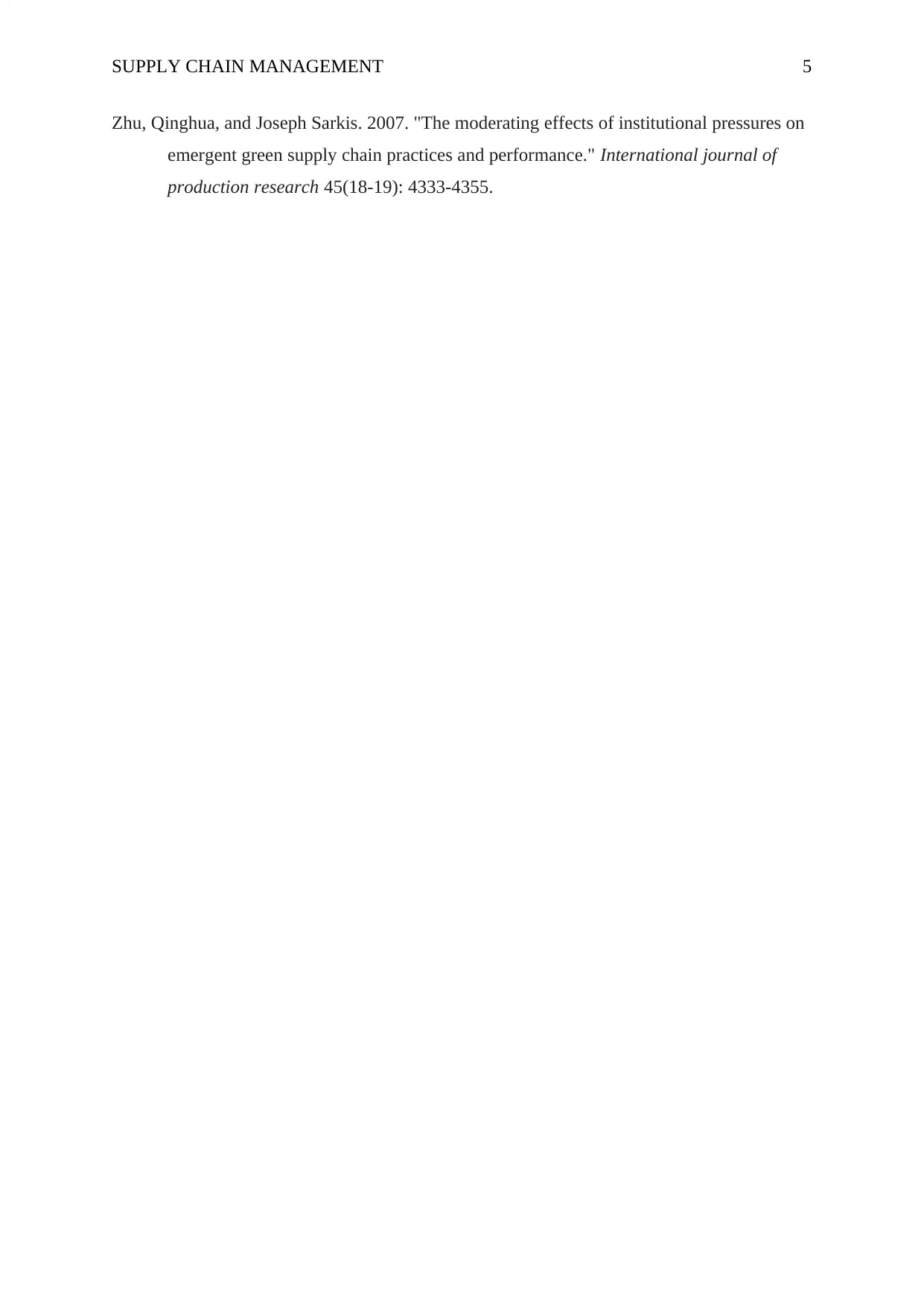
SUPPLY CHAIN MANAGEMENT 5
Zhu, Qinghua, and Joseph Sarkis. 2007. "The moderating effects of institutional pressures on
emergent green supply chain practices and performance." International journal of
production research 45(18-19): 4333-4355.
Zhu, Qinghua, and Joseph Sarkis. 2007. "The moderating effects of institutional pressures on
emergent green supply chain practices and performance." International journal of
production research 45(18-19): 4333-4355.
⊘ This is a preview!⊘
Do you want full access?
Subscribe today to unlock all pages.

Trusted by 1+ million students worldwide
1 out of 6
Related Documents
Your All-in-One AI-Powered Toolkit for Academic Success.
+13062052269
info@desklib.com
Available 24*7 on WhatsApp / Email
![[object Object]](/_next/static/media/star-bottom.7253800d.svg)
Unlock your academic potential
Copyright © 2020–2025 A2Z Services. All Rights Reserved. Developed and managed by ZUCOL.





